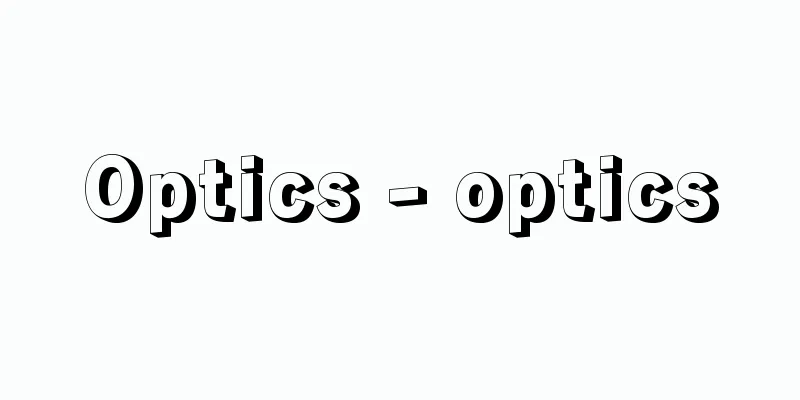Optics - optics

|
It is one of the traditional physics education systems (mechanics, electromagnetism, thermodynamics, vibrations/waves, optics), and is a branch of physics that mainly studies the nature of light, natural phenomena involving light, and the development of devices that use light. "Light" here mainly refers to visible light, infrared light, and ultraviolet light. All optical phenomena can be explained by quantum optics, which incorporates the quantum nature of light, but if quantum nature is not of concern, wave optics based on Maxwell's equations is sufficient. Furthermore, if the polarization state of light and the effects of diffraction as a wave can be ignored, it is convenient to explain them using the concept of geometric optics, which uses only the rectilinearity of light. [Takahiro Kuga June 17, 2015] Geometric OpticsGeometric optics considers the propagation of light as a light ray. It studies how to reproduce the image of an object as accurately as possible by utilizing the property that light rays travel in a straight line in a homogeneous medium, but change direction according to the laws of reflection and refraction when they enter the boundary surface between different media. If the reproduced image is exactly the same as when the object is viewed directly, it is said to be an ideal image, and the imaging system that produced such an image is called an ideal imaging system. If the image differs from the object, it is said to have aberration. Aberration that can be detected even with light of one wavelength, i.e., monochromatic light, is called spherical aberration, and aberration that occurs because the way an image is formed differs depending on the wavelength of light used is called chromatic aberration. In this way, geometric optics studies how to create an image using light rays emitted or reflected from an object. It has also become possible to use light as a new medium for propagating only the information necessary to reproduce the image of an object, rather than the original light rays themselves. This is optical information theory in a broad sense, and includes Fourier imaging theory, holography, image information processing theory, etc. It also includes television broadcasting and the transmission of photographs of stars from space rockets. Geometric optics has come to be interpreted as imaging theory in a broad sense, and these are also included in the subject of geometric optics research. [Kouzo Ishiguro, June 17, 2015] Wave OpticsThis is an academic field that treats light as an oscillation of an electromagnetic field (electromagnetic wave) using the wave equation derived from Maxwell's equation as its fundamental equation. It can explain phenomena and states that cannot be explained by geometric optics, such as the diffraction, interference, and scattering of light, as well as the polarization state. Furthermore, the propagation of light in artificial structures such as optical fibers, photonic crystals, and metamaterials can only be described by wave optics. In addition, a realistic model of light that makes the approximation (paraxial ray approximation) that light energy is concentrated around a single axis (the optical axis) and propagates is also called beam optics. It is useful for describing the propagation of laser light, and also serves as a simple extension of geometric optics. [Takahiro Kuga June 17, 2015] Quantum OpticsA field of study that quantizes electromagnetic fields and treats light as energy quanta. Research into quantum optics has been actively conducted in countries around the world since the late 1980s. It encompasses wave optics and geometric optics, but the only natural phenomena for which the quantum nature of light (quantum optics) is truly necessary to explain are the blackbody radiation spectrum and the spontaneous emission process of light. However, since the beginning of the 21st century, research has progressed from the perspective of quantum information processing, and in the future it is expected that new devices (quantum memory, quantum computers, etc.) and means of information transmission (quantum cryptography, quantum teleportation, etc.) that utilize the quantum nature of light will be developed. [Takahiro Kuga June 17, 2015] [References] | | | | | |Source: Shogakukan Encyclopedia Nipponica About Encyclopedia Nipponica Information | Legend |
|
伝統的な物理の教育体系(力学、電磁気学、熱力学、振動・波動、光学)の一つであり、光の本質や光がかかわる自然現象、そして光を利用した装置開発などをおもな研究対象とする物理学の一分野。ここでいう「光」とは、おもに可視光、赤外光、紫外光のことである。 あらゆる光学現象は、光の量子性までを取り入れた量子光学で説明可能であるが、とくに量子性を議論しないのであれば、マクスウェルの方程式に基づいた波動光学で十分である。さらに、光の偏光状態や波としての回折の効果も無視できるのであれば、光の直進性のみを使った幾何光学の考え方による説明が便利である。 [久我隆弘 2015年6月17日] 幾何光学幾何光学は、光の伝播(でんぱ)を光線という概念でとらえる。そして、光線が均質な媒質中では直進し、異なった媒質との境界面に入射すると反射・屈折の法則に従ってその方向を変えるという性質をもっていることを利用して、被写体の像をできるだけ正確に再現する方法を研究する。再現された像を見たときに、被写体を直接見たときとまったく同じである場合にはその像は理想的な像であるといい、このような像をつくった結像系を理想的な結像系であるという。もしも像が被写体と違っている場合には収差があるという。一つの波長の光、すなわち単色光でも検出される収差を球面収差、使用する光の波長により像のでき方が異なるために生ずる収差を色収差という。このように幾何光学は、被写体から放射され、または反射された光線により像をつくる方法を研究する。また、元の光線そのものではなく、被写体の像を再現するのに必要な情報だけを伝播するための新しい媒体として光を利用することができるようになってきた。これが広義の光学情報論であって、フーリエ結像論、ホログラフィー、画像情報処理論などが含まれる。テレビ放送、宇宙ロケットからの星の写真伝送などもこれに含まれる。なお、幾何光学を広義の結像論と解釈し、これらも幾何光学の研究対象に含めるようになってきた。 [石黒浩三 2015年6月17日] 波動光学マクスウェルの方程式から導かれる波動方程式を基本方程式とし、光を電磁場の振動(電磁波)として取り扱う学問分野。光の回折、干渉、散乱現象や、偏光状態など、幾何光学では説明できない現象、状態が説明可能である。さらに、光ファイバー、フォトニック結晶、メタマテリアルなどの人工構造体中での光伝播も、波動光学でなければ記述できない。 また、現実的な光のモデルとして、一つの軸(光軸)の周りに光のエネルギーが集中して伝播するという近似(近軸光線近似)を行ったものは、ビーム光学ともよばれ、レーザー光の伝播を記述するのに便利なのと同時に、幾何光学の素朴な拡張としての意味ももつ。 [久我隆弘 2015年6月17日] 量子光学電磁場を量子化し、光をエネルギー量子として取り扱う学問分野。1980年代後半から世界各国で盛んに研究が行われるようになった。波動光学、幾何光学を包含するが、自然現象のなかで説明するのに光の量子性(量子光学)が真に必要となるものは、黒体輻射(ふくしゃ)スペクトルと光の自然放出過程ぐらいである。しかし、21世紀に入ってからは、量子情報処理の観点からの研究が進展しており、将来的には光の量子性を利用した新しいデバイス(量子メモリー、量子コンピュータなど)や情報伝達手段(量子暗号、量子テレポーテーションなど)の開発が期待されている。 [久我隆弘 2015年6月17日] [参照項目] | | | | | |出典 小学館 日本大百科全書(ニッポニカ)日本大百科全書(ニッポニカ)について 情報 | 凡例 |
>>: Engineering - kougaku (English spelling) engineering
Recommend
Darlington, CD (English) DarlingtonCD
… There are various theories about the origin of ...
Renshichiro Kawakita
1902-1975 An architect from the Showa period. Bor...
A letter of intent - A letter of intent
…It is also called an addressee-in-charge letter ...
Torilis scabra (English spelling) Torilisscabra
…[Murata Gen]. … *Some of the terminology that me...
Aboriginal
...refers to the indigenous people who lived on t...
SSKresge Co. (English)
...The company was founded in 1899 in Detroit as ...
Danger
…In the early days, stage plays were broadcast as...
Kainic Acid - Kainic Acid
( 2S , 3S , 4S )-2-carboxy-4-isopropenyl-3-pyrrol...
Lake Yamanaka
It is one of the Fuji Five Lakes, located in Yama...
Silent trade
A form of trade that is carried out without the us...
Mujinamo - Mujinamo
A perennial plant of the Droseraceae family (APG ...
Strange web - Kimou
...Around the vertebrae, a blood vessel-rich bloo...
Max Theodor Felix von Laue
German theoretical physicist. Born near Koblenz. ...
Takashi Ono
Born July 26, 1931. Akita gymnast. Graduated from ...
flock
…It is a general term for a group of animals. In ...









![Shimabara [city] - Shimabara](/upload/images/67cbca4bd3a6e.webp)